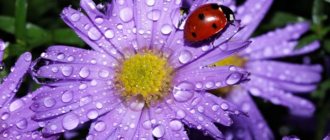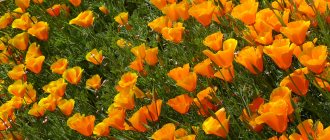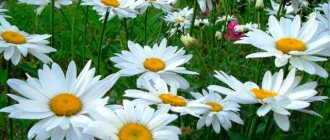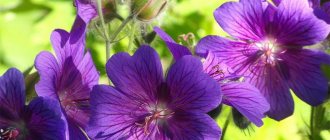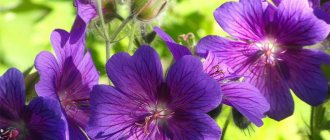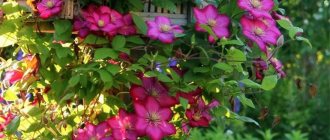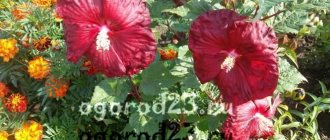Description: varieties and varieties of alpine aster
Aster is one of the most common flowers used in landscape design in open ground and in summer cottages. These flowers delight the eye from spring to late autumn.
Unpretentious bright asters delight the eye of gardeners with their simplicity and grace
The first of the aster family to bloom at the end of May is the perennial alpine aster - a spring-summer flowering plant, up to 25-30 cm high. Typically, the lush flowering of asters lasts more than three to four weeks. Alpine aster flower rosettes are medium in size (do not exceed 4-6 cm in diameter), located one per stem. The shape and arrangement of the petals of the alpine aster resembles a chamomile, which is why it is sometimes called alpine chamomile. This flower is perfect for decorating the foot of an alpine hill and is frost-resistant.
The aster looks very beautiful next to the stones
The variety of colors of the alpine perennial aster contributes to its active use in landscape design. Breeders have developed many varieties of alpine aster with different colors of flower baskets: there are dark purple, bluish-violet, light and dark pink, bright orange flowers.
The most common varieties of alpine aster:
- “Albus” is a low white aster, blooms in the first two months of summer, the stems are short (no higher than 15-20 cm), densely dotted with leaves;
Variety "Albus"
- “Gloria” - flower rosettes are painted in blue tones, inflorescences do not exceed 3 cm in diameter;
Variety "Gloria"
- "Goliath" is distinguished by light purple flower rosettes about 6 cm in diameter. It blooms for about a month, the beginning of flowering is June;
Variety "Goliath"
- "Rosea" - a pink flower, flower rosettes up to 4 cm in diameter;
Variety "Rosea"
- "Happy End" is distinguished by strong, straight stems, abundantly covered with leaves. It blooms in May, the flowering period is quite long - about a month;
Variety "Happy End"
- "Dunkle Schöne" - a spectacular dark purple aster, inflorescences about 3 cm;
Variety "Dunkle Schöne"
- “Ruber” is an unusual red-pink aster, flower rosettes up to 4 cm;
Variety "Ruber"
- “Superbus” is an aster of lilac-blue tones, flower rosettes about 3.5 cm in diameter.
Variety "Superbus"
Characteristics of the variety
The species was cultivated in the 16th century. It unites a group of herbaceous perennial ground cover plants. The rhizome of the alpine aster is branched and horizontal. The shoots do not exceed 30 cm in height. The branches below are covered with oblong leaves with slight pubescence, on top they are linear, small, sessile. The bushes reach 50 cm in diameter. Sprawling, the aster covers the ground with a colorful carpet, decorating it, preventing the growth of weeds and the evaporation of moisture. The flowering period of the mountain aster depends on the climate and variety.
Spring varieties bloom from May to June, summer varieties bloom in July and August. Autumn varieties bloom in the fall. Their flowering can last from the first days of September to the end of October.
The perennial inflorescences are single baskets. The color of the marginal flowers is reed-shaped, delicate, pastel. They can be pale or bright lilac, pure white, lilac, blue or violet.
In the middle there are tubular bright yellow flowers. The size of the inflorescences is 4-5 cm in diameter. In appearance, they resemble daisies. July and August are the period of seed ripening. The bushes greet the winter green.
Planting a plant
Before planting the plant in open ground, you need to choose a suitable location: all perennial asters love a well-lit sunny place. Before planting asters, it is recommended to fertilize the soil (phosphate preparations are used), dig it up, pick out all the weeds and moisten it.
Aster does not need any special care, just watering, loosening and a well-chosen place for planting
It is advisable to add about 200 g of lime (can be replaced with dolomite flour) and about 100 g of superphosphate to the soil before digging the soil and planting the aster. You should dig to a depth of 30 cm.
Attention! Damp, flooded soils are absolutely not suitable for planting asters. Under such conditions, the plant becomes infected with powdery mildew and simply dies.
How to grow?
Heather aster does not require much care. She is not capricious and unpretentious
And yet, in order for the plant to receive all the conditions for normal growth and development, it is necessary to pay attention to the following nuances:
Asters will do well on the floor - a darkened or sunny area. In order for a plant to delight you with abundant flowering, its conditions must be similar to natural ones. The flower should not be kept in very dark places, as it will be attacked by harmful insects and will often get sick.
The wild variety of aster can grow in any soil. The exception will be heavy, swampy and saline soil. Growing a cultivated flower, the heather aster, requires more careful care. And you need to start from the soil. Loamy and fertilized soil will be optimal, into which fertilizers will need to be applied. You should also ensure good drainage. If there are no microelements in the soil in the selected area, you should first fertilize the soil with organic fertilizers consisting of compost or humus before planting the aster. Spring planting of flowers requires adding nitrogen to the soil, which is necessary to accelerate the growth of the flower.
Plant care
Alpine aster is a perennial, easy to care for. It is necessary to ensure timely watering of the plant (infrequently, but plentifully) and loosening the soil, weeding. Lack of moisture can lead to loss of decorative appearance of flower baskets and their drying out. Before flowering, it is recommended to hill the crop to a height of 5-6 cm, thus accelerating the growth of the root system and its strengthening. During the flowering period, it is necessary to remove dried plants.
Remove weeds from flower beds in a timely manner so that they do not interfere with the growth and development of the aster
The flower is frost-resistant, but for frosty winters it is recommended to mulch the perennial with soil or sand, taking into account that the plant buds must be covered.
Rules for planting aster
Planting must be carried out in accordance with certain requirements. Gardeners advise planting in early May. The soil should be slightly moist. The interval between sprouts should be fifteen to twenty centimeters. Three days after planting, the first watering is required. After seven days, fertilize with mullein solution. It is better to carry out work in the evening. It is good to conduct them in cloudy weather. If the sun is shining, the seedlings should be covered for a certain period until they take root.
Recommendations for plant care
Professional gardeners explain that planting and caring for heather aster is a simple procedure. You should follow simple rules, which will ensure decorativeness and good flowering of plants. Watering should be regular but moderate. Water is taken that has settled. During the dry period, it is necessary to provide abundant watering, but it is better to stick to the golden mean so as not to overdo it with watering. In this case, it is necessary to prevent water from getting on the leaves of the heather aster.
In order for the aster to delight with abundant flowering, it must be fertilized at least three times per season. To do this, use complete mineral or organic fertilizers. Adding ash to the soil gives good results. This helps to reduce the acidity of the soil and enrich it with potassium.
It is recommended to periodically loosen the trunk circles of the New England aster to provide the rhizomes with the necessary oxygen. But loosening should be superficial, to a depth of no more than six cm. This is explained by the superficial root system. In conditions of insufficient air exchange and nutrients, disease is inevitable. They can be caused by fungi.
Weeds and fading inflorescences should be removed promptly. Since the crop can withstand frost, it is not covered for the winter, but only the above-ground part is cut off, leaving 20-30 cm above the ground. When the plant reaches a height of fifty to seventy-five centimeters, a support should be installed. It will provide support to the plant during the growth process. You can prevent diseases and stimulate abundant flowering by planting asters every 2-3 years. The best period will be April. If the heather aster was not pruned for wintering, then the dried shoots are removed in early spring.
Pests of heather aster
Periodically, shrubs need to be inspected for timely detection of diseases. In dry weather, the crop is threatened by spider mites, which can be controlled with an acaricide or an infusion of onion peels. The danger is represented by a nematode that causes brown spots to appear. Damaged leaves are removed manually. If this does not help, then the entire bush should be removed.
Powdery mildew in the form of a white coating can damage plantings. This is especially true in rainy weather. To combat this disease, fungicides of synthetic origin are used, as well as products containing copper. The most effective drugs are Topaz, Skor, etc. For preventive measures, copper sulfate or Bordeaux mixture is used.
Fusarium wilt can lead to the death of the bush. There are currently no effective drugs for it. The plant is removed and then burned. The danger threatens plants on loamy acidic soil at high daytime temperatures. You can fight the meadow bug with the help of such means as Aktara, Decis. The insecticide needs to be changed periodically so as not to cause the pests to become addicted.
Plant propagation
Alpine aster is propagated in two ways: by seeds and by dividing a bush that has been growing for a couple of years.
Aster seeds
seeds are collected in late autumn after flowering has ended, planted in fertilized soil and covered with film to obtain a greenhouse effect. The resulting seedlings germinate in March-April, after the first leaves appear. Asters grown from seeds bloom in open ground only in the second year. This propagation method is quite labor-intensive, since seed germination is low.
Dividing an aster bush (vegetative method) is a simple and quick method of propagation and planting new areas with flowers. It is necessary to separate part of the bush along with the rhizome in the spring after rapid growth begins, remove weak stems and replant it in a new place.
Advice. Aster can grow in one place for up to 7 years, but to renew the bush and maintain lush flowering, it is recommended to replant the crop every three years.
Alpine aster tolerates bush division quite well
be propagated by cuttings all summer long . The tops of the shoots are suitable for this; their recommended length is about 6 cm. The cuttings should be planted in specially prepared beds with special soil (turf soil, peat, sand in a ratio of 2 parts soil to 1 part peat and 1 part sand) in partial shade, covered with agrofibre. Rooting time for cuttings is about 1 month. Young shoots up to 15 cm tall, cut into several parts, each of which should have 3 leaves, can be used as cuttings. In August-September, such cuttings can be planted in a permanent place of growth.
Ways to grow a flower
The method of growing aster depends on the temperature conditions during the cold season.
Seeds
In regions where the winter temperature does not drop below -20 degrees and there are no long-term return colds in the spring, aster is grown from seeds. To do this, they are sown in the ground in November or May.
In a sunny area, shallow furrows (up to 1 centimeter deep) are made in loose soil. Aster seeds are pre-treated with a biostimulant to speed up the growth process and disinfected.
Since the seeds of asters are very small, they are sprinkled in the grooves with soil mixed with river sand. To avoid replanting the plants in the future, the distance between the grooves should be at least 40 centimeters. Plantings that are dense in a row are thinned out as they strengthen and grow, leaving a distance between seedlings of 15-20 centimeters.
In the first year after sowing, the aster produces a basal rosette of leaves without throwing out flower stalks. Buds appear the next year.
Seedlings
In cold regions, alpine aster is grown on site through seedlings. Sowing time is the end of February. It is necessary to prepare a plastic container with holes to drain excess water.
The drainage layer is laid out from broken bricks and expanded clay. The soil is loose. Prepared aster seeds are sown in the same way as planting in the ground. Moisten well, cover with film and place in a warm place. When the sprouts hatch, you need to move the container to a well-lit and cool place to avoid being pulled out.
When the aster has 3 true leaves, a pick is carried out, replanting the plants with a lump of earth into cups. Planting in a permanent place is carried out in May and early June, when there is no threat of frost. Asters must first be accustomed to fresh air and exposure to direct sunlight.
Asters begin hardening by taking the seedlings out onto the balcony in warm, calm weather. The first days the plants are shaded and kept for 15-20 minutes. Over the course of 15-20 days, the aster’s time in natural conditions is adjusted to the length of daylight hours, regardless of weather conditions.
As when sowing seeds, the area should not be shaded, the soil should be nutritious sandy loam, fertilized loam.
For each bush, dig a hole 2 centimeters larger than the earthen ball with roots. Planting of asters: 40 centimeters between rows, 20 centimeters in a row.
Diseases and pests
The alpine perennial aster is ideal for creating landscape design, is resistant to many diseases and pests, and is unpretentious in cultivation. However, in damp summers, if asters are improperly watered or planted in damp, waterlogged soil, the likelihood of the perennial becoming infected with powdery mildew increases sharply.
The disease is transmitted from plant to plant by air. The affected area depends on the density of asters and the presence of moisture on the leaves. In order to prevent this disease, it is recommended to treat flowers with Topaz twice before flowering. Topaz should be diluted at the rate of 2 ml of the drug per 10 liters of water.
Powdery mildew control agent
In the fall, it is recommended to treat alpine aster with copper sulfate (dilute 50 g of the drug in a standard 10-liter bucket of water), after which the plants need to be cut.
Infected shoots should be cut and burned, as the powdery mildew fungus can remain on the leaves and stems of the plant all winter, and in the spring it will release new spores and infect nearby flowers.
Biofungicides are used to treat asters:
- "Topaz".
- "Fitosporin".
- "Alirin" and "Gamair".
Copper sulfate and its solution for treating plants
There are other ways to protect plants:
- spraying with an ash solution (dilute 1 kg of wood ash in 10 liters of warm water, leave to infuse for 6-7 days. The drug is applied by spraying the leaf surface three times);
- treatment with a solution of laundry soap and copper sulfate (mix 100 g of laundry soap with 5 g of copper sulfate, treat the plants twice).
In addition, in the summer, during the active growth phase of the perennial, it is recommended to carry out three root feedings of the aster with stimulants. At the beginning of budding, asters are treated with the drug “Energen” (recommended dose: 1 capsule per half bucket of water). Then, during flowering, you need to give a second dose: the drug “Agricola for flowering plants” is used (about 30-35 g per bucket of water). The third time the plant is fed in August with potassium sulfate: 30 g per bucket of water.
Growing asters from seeds
Aster is grown from seeds in two ways: seedlings and non-seedlings.
Non-seedling planting of asters
Sowing of early varieties is carried out in early or mid-March, and later varieties - in the second half of spring, when consistently warm weather above 10°C has established.
Wherein:
- Grooves 4 cm deep are prepared.
- Seeds are placed in the grooves and filled with water.
- With the arrival of dry weather, the crops are mulched.
- After the seedlings have formed two pairs of true leaves, the rows are thinned out so that there is an interval of 15 cm between the seedlings.
In addition to spring, asters are planted in the fall before winter:
- Grooves are made along the frozen soil into which seed is placed, which is practically not damaged by fusarium.
- After the snow melts in the spring and seedlings appear, thinning is carried out.
Sowing aster for seedlings
The seedling method is more reliable, and the grower will be able to admire asters grown through seedlings much earlier.
Sowing is carried out in the first half of spring as follows:
- 7 days before sowing, the seed, wrapped in cloth, is soaked in a manganese solution for 10 hours.
- After the allotted time, the fabric is wrung out and, along with the seeds, placed in cellophane for germination.
- The seedling boxes are filled with a light substrate, which is watered with a fungicidal solution for disinfection.
- Seeds are planted to a depth of 5 mm.
- The container is covered with glass and then moved to a warm place.
- When shoots appear, the seedlings are taken into a room with a temperature of 16°C.
- After the seedlings have two pairs of true leaves, they are picked and the roots are shortened.
Alpine aster: combination with other plants
Alpine aster blooms for quite a long time; it can serve as a background for other flowers, gradually replacing each other from spring to autumn.
Asters of different colors can look great in a flowerbed.
Border irises, cypress spurge, evening primrose, multicolored spurge, and dotted loosestrife, which are painted in bright yellow, look impressive against the background of purple asters. The combination of bearded irises and alpine asters looks interesting - by planting blue or lilac varieties nearby, you can create a composition that is pleasing to the eye, playing on a smooth change of halftones.
Astra goes well with:
- violets;
- geraniums;
- roses
- large sedum;
- prominent sedum;
- white woodwood;
- incense;
- Thunberg barberries;
- Spiria japonica.
Alpine aster in a flower bed
Experienced gardeners willingly include Julia primrose, reed grass, spartina, and creeping thyme in a composition with alpine aster. Successful partners for perennial aster are ornamental grasses.
Features of heather aster
Abundantly flowering inflorescences bend towards the ground, creating dense bushes. They are characterized by an oval-pyramidal shape. Gardeners have the opportunity to develop unusual compositions. A variety of baskets and flowers create a unique carpet. This culture is the best for developing landscape design in a garden or park.
Groundcover aster is characterized by abundant, long-lasting flowering. Heather aster can withstand temperatures down to −35 degrees. Heather aster is common in Europe and America. There it is planted in almost every garden plot.
What varieties of this species are there?
This crop is distinguished by its variety of varieties. It is also called a long-liver in the flowerbed, when other flowers have already faded, but it continues to delight the eye with its blooms. Herbstmyrthe is a gorgeous hybrid, over one meter high. The flowers are characterized by a white-lilac hue, the inflorescences are paniculate. The size in diameter is 10-12 mm. The flowers in the middle are yellow. They bloom in early September, delighting with flowering for a month and a half.
Erlkönig, this variety has a soft lilac petal color. The middle of the flower is bright yellow. The bush is characterized by branching, its height is no more than ten centimeters. Abundant flowering occurs in late September until November.
Bluestar is an unusual creeping heather aster. The bush reaches seventy centimeters in height. Since the foliage is small, needle-like, and the branches are squat, the heather aster resembles a low-growing conifer. Flowering continues from early August until the first frost, long and abundant.
Lady in Black is unusually decorative due to its almost black foliage, pinkish-brownish center and white tips of the petals. Many gardeners prefer this groundcover perennial for landscaping.
Aster heather snow town (Snow flurry) is a delightful ground cover that looks great in rock crevices and alpine slides. The abundant green carpet reaches only 10 cm and grows quickly. When flowering begins, the tiny white flowers resemble an avalanche. Hanging pots are well suited for growing hanging crops.
The pink cloud grows in the form of spherical bushes. Pale pink inflorescences are collected in numerous baskets. The variety is quite decorative; its charming appearance is maintained throughout the entire flowering period.
Many lovers of landscape design are attracted by the Golden Spray variety, which is a pyramidal bush in shape. The flowers are small, snow-white, and the center is deep yellow. It is quite large against the background of small flowers.
There are low-growing and tall-growing varieties. The latter includes the popular variety Royal Ruby, whose height reaches 1 m. The bush is quite vigorous. Paniculate inflorescences number up to 200 baskets. Flowering continues for two months.
Alpine aster in landscape design
Since the perennial alpine aster is quite unpretentious in cultivation, it is actively used in landscape design by gardeners and simply lovers of wildlife in flower beds, rock gardens, in the design of flower beds, rocky hills, as a balcony plant.
It is recommended to plant alpine asters in the foreground of shrub plantings, in borders, and to decorate the banks of small garden or country ponds.
The perennial alpine aster is equally loved by experienced landscape designers and amateur gardeners. It is easy to care for, does not require special watering conditions, but at the same time it delights almost the whole summer with bright colors, emphasizing the beauty of the surrounding nature. Give your attention to the alpine aster, and it will reward you with lush flowering.
Planting perennial asters: video
Alpine aster: photo
When and how does it bloom
On average, flowering of each variety lasts 30-45 days.
The inflorescence is a basket in which the central tubular flowers have short yellow corollas, and the outer tier is formed of long flowers of pink, white, blue, and purple. Some hybrids may have a basket entirely of one shade.
The shape of the inflorescence is usually similar to a daisy, whose long petals can have a simple, pointed shape with a wavy edge.
Most of the varieties available for sale bloom in May-June, but in nurseries you can also find others that bloom towards the end of summer.
When the bushes bloom, their water consumption increases significantly. If the rest of the time, if there is enough rain, the planting can not be watered at all, but during flowering, watering is necessary every week. If the seeds are not needed, dry flowers are removed to make the bushes look more beautiful.
Boarding instructions
Growing aster by simple sowing is a delicate matter. This perennial with small seeds is best sown for seedlings in fine soil, at a distance of 2.5 to 3 cm from each other. To a depth of up to 2 cm. Germinates in 15 to 25 days with an optimal soil temperature of +20 to +25 degrees. Germination is improved by pre-chilling the seeds in the refrigerator two to three weeks before planting.
Alpine aster grows best when sown in a planting container, as such a habitat is easier to control. Fill the container with light, airy, sterilized soil; the container itself must have drainage holes. Cultivation by sowing seeds into the soil occurs by direct sowing, covering with a thin layer of dry soil. For the best contact of seeds with the soil, they are lightly pressed. Next, cover the container with newspaper to reduce evaporation and keep the soil moist until seedlings begin to appear. After this, immediately remove the cover, otherwise the seedlings will not begin to germinate.
When the seedlings show their first green leaves, you will need water with a liquid solution of Kemira complex fertilizer, strictly according to the instructions. Repeat fertilizing every two weeks, placing the container in the sun.
When the seedlings have their first set of true leaves, they need to be transplanted into separate plastic pots. Next, the plants grow in full sun, with cool nights, from +10 to +14 at night. After the last frost, it is necessary to move the pots outdoors until the plants are well hardened and have a height of 5 to 8 cm, then they are planted in a permanent place. Planted in the evening in pre-watered holes. After planting, the seedlings are immediately watered with water with the addition of ½ liter per bucket of water, a liquid solution of potassium humate, to reduce the shock of transplantation. Keep new plantings moist and continue infrequent but even watering until flowering stops.
